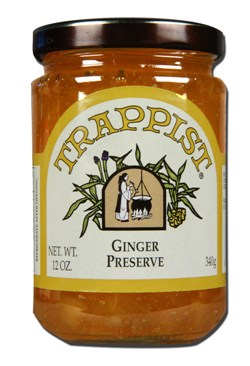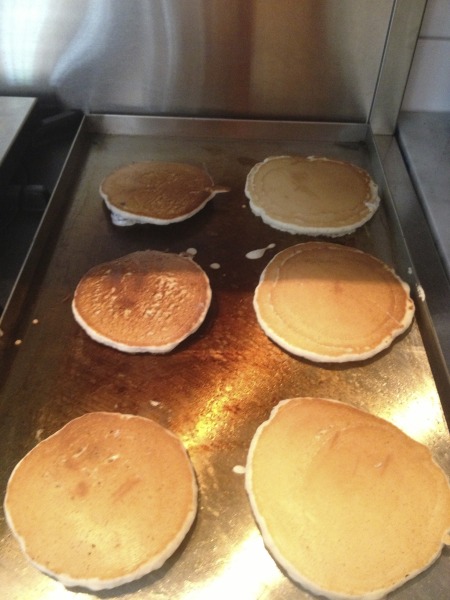Since the early 1900s, Americans proclaimed corned beef and cabbage to be their favorite Irish dish, even though it really never had graced dinner tables in Ireland. Since then, Americans have embraced it as the meal of choice for St. Patrick's Day, March 17th. Corned beef got its name before refrigeration, when meat was preserved using coarse grains of salt, called 'corn'. Today, beef is corned with spices strictly for flavor, not for preservation, so the meat must be refrigerated. Whether you're a wee bit Irish or not, boost your luck by celebrating St. Patrick's Day with friends and a feast. 
Monks in a Jam
One of my favorite TV segments of all time was created on my trip to Spencer, Massachusetts; visiting Father Robert at St. Joseph's Abbey, seeing how Trappist Preserves are made and how it came to be. It was one of the most inspirational experiences to witness the dedication and commitment to a lifestyle that gives so many people pleasure. In fact, the Trappist Monks create a bit of happiness in every serving. I mean- who doesn't smile after having jam on toast? Better yet, really good jam!

Time for Shrove Tuesday
 George's Griddle Cakes
George's Griddle Cakes
Making the Best Fish and Chips
Buying food and reading labels can be a dizzying task. One can't help but be overrun with questions like - Is this good for me and my family? Is it safe to eat? Where did this come from? Is this sustainable? Reading labels can work most of the time, but what if there’s no label, as with fish? You would think if a fish has been around since the beginning of time and spawned billions of eggs - there wouldn’t be any problem, right? But not so fast, too much of anything can be harmful, even cod.
Here's a solution - Seafood Watch, provided by the same folks who operate the Monterey Bay Aquarium; which by the way is a fantastic experience to visit in itself. I’ve had the occasion to visit for both leisure and as a keynote speaker and celebrity chef a few years back to kick off the Monterey Food & Wine Classic.
Pardon me while I digress, I will get right back to cod...While I have you in Monterey, I want to mention a one degree of separation between John Steinbeck’s Cannery Row (the gritty side of life in this seaside post depression novel) and lovely Monterey. One of my friend’s families was the basis of a character in Steinbeck's tome. It is also that same good friend, Bert Cutino from the famed Tortilla Flat neighborhood on Canary Row who owns the famed Sardine Factory, a must stop when in town.
Now, back to the cod. With it’s mild flavor, low fat content and a dense, flaky white flesh, it's no wonder cod is one of the most common fish used for fish & chips along with haddock and plaice. But, did you know it is currently at risk from over fishing in UK, Canada and other Atlantic waters? So be in the know with Seafood Watch. Use this guide to find ocean-friendly alternatives to seafood on the Seafood Watch “Avoid” list. It’s a good thing to use discretion and follow their lead so in the future when we are calling all cods, there are still some around.
Best Choices: Cobia (US farmed), Cod- Pacific (trap, hook-and-line, longline from AK)
Good Alternatives: Cod- Atlantic (Northeast Arctic and Iceland), Cod- Pacific (U.S. trawl)
Avoid: Cod: Atlantic, Iceland and Northeast Arctic (trawled), and Pacific (imported)
The carbonation in the beer makes the batter exceptionally airy and produces a crispy coating. Malt vinegar is a British favorite on fish and chips.
 George Hirsch Beer Batter Cod
George Hirsch Beer Batter Cod
George's Beer Batter Cod
Recipe by George Hirsch, Know Your Fire Cookbook, Putnam 1997
1 1/4 cups all-purpose flour
1/4 cup sugar
2 teaspoons baking powder
Freshly ground black pepper to taste
2 eggs
1 teaspoon hot sauce
1 cup beer, a strong full flavored Stout or IPA
vegetable oil for frying
2 pounds cod fillet, cut into serving pieces
Malt vinegar for serving
Combine 1 cup of the flour, sugar, baking powder and black pepper in a medium bowl. Stir in the eggs and hot sauce. Slowly pour in the beer, stirring constantly, until the foam subsides and the batter is smooth. Let the batter rest for 15 to 20 minutes.
Heat 2 to 3 inches of oil to 370 degrees F. in a deep sauce pan or deep-fat fryer.
Dredge the the cod in the remaining 1/4 cup flour, shaking off any excess, and dip into the batter.
Carefully slip the pieces into the hot fat and cook until brown on both sides, turning once. Drain on paper towels. Serve with french fries and malt vinegar.
National OCD
Why wait for National Oatmeal Cookie Day (OCD) on March 18th. Now is the time to make a big batch. I created this recipe with a healthy spin on the cookie, see the apple sauce and no oil. But you'll just have to see for yourself - oh and share with the kids. The true secret is in the quality of the rolled oats. Now, who doesn't like a fresh-baked oatmeal cookie?
George's Low Fat Oatmeal Cookies
Recipe by George Hirsch | Makes 1 1/2 to 2 dozen cookies
From George Hirsch Living it UP! TV series companion cookbook
6 Tablespoons butter
1/4 cup apple sauce
1/2 cup brown sugar
1/2 cup sugar
2 egg whites
1 1/2 rolled oats (not quick-cooking)
3/4 cup all purpose flour
1/4 teaspoon salt
1/2 teaspoon baking soda
1/4 cup raisins
1 teaspoon vanilla
2 Tablespoons pecans, chopped
Preheat oven 350° F. Follow Recipe Below
Mix the butter, applesauce, brown sugar, sugar, egg and vanilla. Beat until creamy. Sift the flour with salt and baking soda. Add to creamed mixture, blending well. Fold in the oats, raisins and nuts.
Make into 1-inch balls and place on a cookie sheet. Bake for 9-11 minutes or until the edges begin to set.
TIP: Do not over bake! The cookies will carry the heat and continue to bake when removed from the oven.







